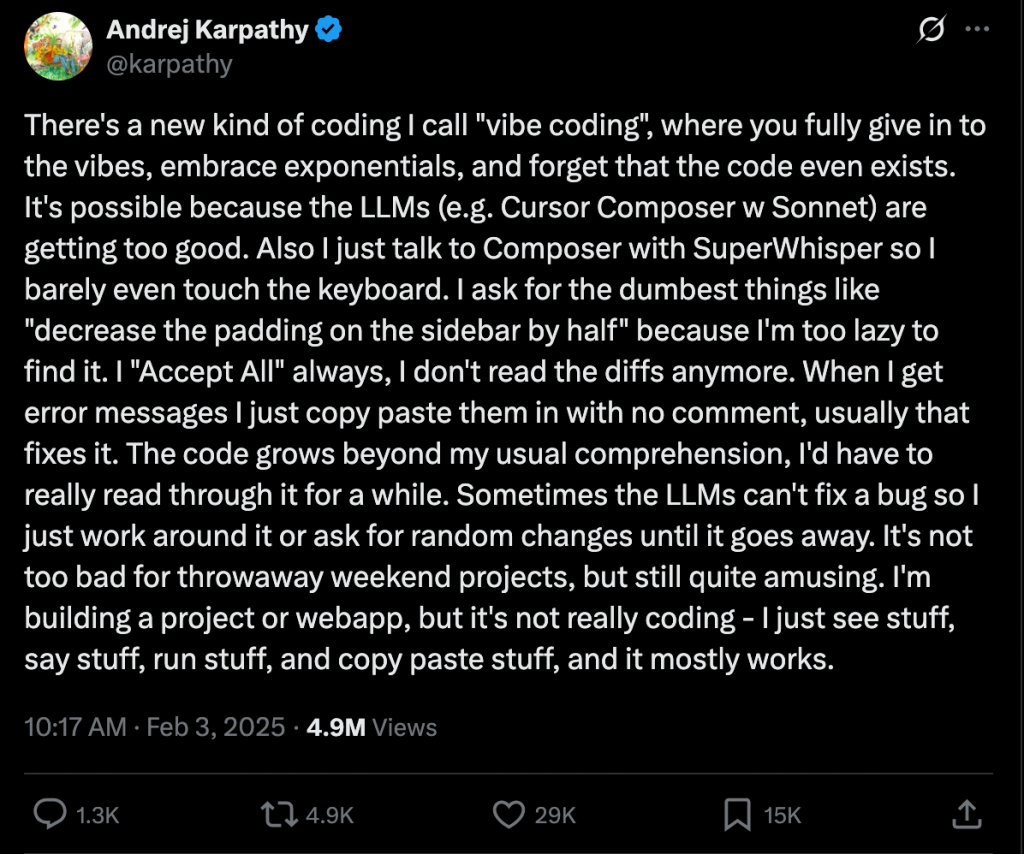How AI-Powered Vibe-Coding Is Transforming Software Development Agencies

A cute robot is developing in a laptop. AI-generated content.
TL;DR: Vibe-coding uses AI to turn plain-language ideas into code, speeding up development and boosting creativity without replacing developers.
Summary: Vibe-coding is transforming how development agencies work by using AI to streamline prototyping, enhance collaboration, and support more flexible workflows. This allows your team to deliver projects faster, stay creative, and focus more on client impact.
Vibe-coding is transforming how software development agencies deliver software by combining AI-assisted development with natural language programming. Instead of writing every line of code manually, your team can describe features in plain language, then let AI-powered code generation tools turn those ideas into working code. The result? Faster prototyping, more creative momentum, and smoother cross-functional collaboration.
Whether you’re a CTO, DevOps lead, SaaS founder, or product manager, this article breaks down what vibe-coding means for your agency’s workflow. You’ll also find real-world examples and practical steps to start integrating AI-driven development into your client projects.
What Is Vibe-Coding?
At its core, vibe-coding is the practice of using AI code generation tools like ChatGPT, GitHub Copilot, or Claude to generate code from natural language prompts. Instead of typing everything line-by-line, your team describes what they want, and the AI builds it.
For example, say, “Build a clean login screen with a password reset button,” and the AI generates the code. This frees your developers to focus on higher-level work like user experience, system design, and architecture without getting bogged down in boilerplate or syntax.

The term “vibe-coding” gained momentum in 2024, inspired by AI advocate Andrej Karpathy, who described the process as “seeing things, saying things, running things, and copy-pasting.” It feels more like collaborating with an assistant than traditional coding.
Traditional Development vs. Vibe-Coding: What’s the Difference?
If your agency is used to structured, step-by-step development (carefully planning features, writing code line by line, and testing as you go), you’re following a traditional model. Vibe-coding takes a new, faster path built on flexibility and iteration.
Here’s a quick look at how the traditional development and vibe-coding for agencies compare:
Traditional Development
Vibe-Coding
Manual, line-by-line coding
Code is generated from natural language prompts
Follows detailed specs and workflows
Encourages fluid, iterative, and creative development
Requires heavy setup before prototyping
Enables near-instant prototyping from prompts
Prioritizes engineering precision and structure
Emphasizes speed, design thinking, and rapid iteration
Uses IDEs, compilers, and linters
Uses AI code generation tools like ChatGPT, GitHub Copilot, Claude
Ideal for large-scale, production-grade systems
Ideal for MVPs, prototyping, and fast client feedback loops
For agencies, vibe-coding doesn’t replace your team — it amplifies it. If used strategically, it lets you move faster, deliver earlier, and spend more time solving meaningful problems.

ai-generated content.

ai-generated content.
What Can You Build with Vibe-Coding?
Vibe-coding is surprisingly versatile. If you can describe it, you can start building it. And it’s not just for hobbies or side projects. It’s already being used by serious teams across a wide range of applications:
- Websites: Quickly generate layouts, components, and responsive styling in minutes using prompts.
- Mobile apps: Build cross-platform interfaces and backend logic with AI-assisted UI flows.
- Games: Prototype game mechanics, character behavior, or UI elements without starting from scratch.
- Internal tools: Automate dashboards, CRUD apps, form validation, and reporting with minimal overhead.
- Prototypes and MVPs: Validate ideas quickly even without a full-stack team by turning plain-language prompts into working prototypes.
How Natural Language and AI Combine in Vibe-Coding Workflows
It all starts with your idea; maybe it’s a dashboard, a landing page, or a mobile onboarding flow. Instead of writing everything from scratch, your team describes the feature in natural language. That prompt goes into an AI assistant like GitHub Copilot, ChatGPT, or Claude.
From there, the AI generates code snippets in HTML, CSS, JavaScript, or even backend logic. Your developers can review, tweak, and iterate immediately. Want a different layout or feature? Just revise the prompt and try again.
Importantly, AI isn’t replacing your devs — it’s accelerating them. Your team still drives design, architecture, and user experience. The AI handles the boilerplate so you can stay focused on what matters most.
Once code is generated, drop it into your dev or staging environment to test early. This helps you catch bugs early, validate ideas, and keep momentum high. AI can even help write documentation, insert comments, or clean up basic errors during review.
When your prototype is ready, bring in senior engineers or the QA team to polish the code and ensure it meets your standards for quality, security, and scalability.
How Generative AI and AI Coding Tools Power Vibe-Coding
At the heart of vibe-coding is generative AI, reshaping how development teams write, debug, and ship software. These AI coding tools don’t just autocomplete code; they act as intelligent collaborators that help your team move faster with fewer roadblocks.
AI Code Generation Tools That Remove Friction
Generative AI assistants take care of repetitive, time-consuming tasks like boilerplate, bug fixing, and documentation. That frees your developers to focus on creative problem-solving, system design, and strategic features.
What are the best AI tools for development teams? Here are some of them:
AI Tool
Key Features
Best For
Integrations
GitHub Copilot
Code suggestions, bug fixing, auto-docs
End-to-end coding assistance
VS Code, JetBrains, Neovim
ChatGPT
Natural language prompts, code gen + refinement
Fast prototyping and ideation
API, web
Tabnine
Code completions, refactoring, doc generation
Boosting code quality + development speed
Multiple IDEs
Amazon Q Dev
Secure code generation, bug fixes, test coverage
Enterprise-grade, secure dev
Leading IDEs
Replit
Cloud IDE, real-time suggestions + test environment
Remote teams and live collaboration
Web-based
Other top tools that support vibe-coding: Cursor, Cody (Sourcegraph), Gemini Code Assist, Windsurf, AskCodi, Qodo, Bolt.new, CodeGPT, and more.
How AI Collaborates With You
Vibe-coding isn’t just about automation. It’s a creative partnership. Generative AI adapts to your intent, your tone, and your workflow to help your team move from idea to execution more seamlessly.
- Speak in moods, not just specs: Want “a cozy, calming UI design for a meditation app” or “an edgy landing page for Gen Z gamers”? Generative AI tools interpret that emotional context and translate it into design and code that fits the tone. This semantic interface bridges creative vision and technical execution.
- Real-time co-building: Whether you’re debugging, prototyping, or planning architecture, modern AI code generation tools respond live to your inputs. It’s like working with a tireless, ultra-fast pair programmer who’s always available and ready to refine, suggest, or fix code as you build.
5 Benefits of Vibe-Coding for Software Development Agencies
AI-assisted coding is no longer experimental. It’s actively changing how modern development agencies operate. Whether you’re delivering MVPs, building internal tools, or scaling enterprise software, vibe-coding helps your team move faster, collaborate more effectively, and do more with less.
Here’s why more software development agencies are embracing generative AI tools in their workflows.
1. Deliver Projects Faster
Vibe-coding helps you go from idea to interactive prototype in hours, not weeks. That means tighter feedback loops, faster approvals, and the flexibility to pivot quickly when client priorities change.
2. Do More with Leaner Teams
By offloading 30–50% of repetitive coding tasks (like CRUD, UI scaffolding, and test generation) to AI, your team can handle more projects without increasing headcount. This boosts velocity, improves margins, and reduces burnout.
3. Improve Developer Productivity and Satisfaction
According to a 2023 GitHub trial, developers using Copilot completed tasks over 55% faster. Another industry survey reported 81% saw productivity boosts.
But it’s not just about speed. Developers also report greater job satisfaction when they can focus on creative, meaningful work instead of boilerplate. Gen Z and millennial engineers in particular thrive in these flexible, fast-paced AI-assisted development workflows.
4. Strengthen Client Collaboration
Clients today expect more than a status update. They want to be part of the process. Vibe-coding allows you to co-create in real-time using natural language prompts, live demos, and rapid iteration. Clients can offer feedback as you build, see changes immediately, and feel more connected to the final product.
This transparency builds trust, improves alignment, and accelerates the review process.
5. Turn AI Investments into Real ROI
If your agency is already experimenting with AI code generation tools, vibe-coding helps bring those investments into day-to-day workflows. AI coding tools like ChatGPT, Claude, and GitHub Copilot move from “nice to have” to essential infrastructure, delivering tangible results and giving your agency a competitive edge.
How to Implement Vibe-Coding Into Your Agency’s Workflow
To get the most out of vibe-coding, integrate it as a natural extension of your current development process to boost innovation and efficiency without disrupting what already works. Here’s a step-by-step guide to help your agency integrate vibe-coding effectively and maximize its impact:
1. Evaluate Your Current Workflow
Start by assessing your existing processes. Where are the bottlenecks? Where does repetitive work slow your team down? Look at areas where AI can improve speed, quality, or collaboration. Be prepared to foster a culture that prioritizes teamwork, creativity, and client involvement.
2. Choose the Right AI-powered Code Generation Tools
Select AI platforms that align with your tech stack and project needs (tools like GitHub Copilot, Cursor, Claude, or Amazon Q Developer). Ensure they integrate smoothly with your codebase repositories, IDEs, and project management systems.
3. Update Your Development Process
Incorporate steps like collaborative prompt creation, AI-powered rapid prototyping, and real-time feedback loops. Use AI to generate automated testing and deployment scripts to reduce manual overhead and streamline delivery.
4. Empower Cross-Functional Teams
Give product managers, designers, and other non-developers access to tools and guidance for contributing via clear AI prompts. This enables faster iteration, stronger alignment, and real-time feedback from all stakeholders.
5. Maintain Human Oversight and Quality
While AI can speed things up, human review remains essential. Developers should always validate AI-generated code for quality, security, and long-term maintainability. Include multiple peer reviews and compliance checks, especially for regulated industries or sensitive applications.
6. Start Small, Then Scale
Pilot vibe-coding on internal tools, MVPs, or non-critical projects. Use early results to refine your approach, then roll it out across large, more complex builds as confidence grows.
7. Invest in Ongoing Training and Change Management
Ensure your team stays current on prompt engineering, AI best practices, and new tools. Provide ongoing training and gather feedback to continually improve how vibe-coding fits into your agency’s unique workflow.
Team Roles and Cultural Shifts in Vibe-Coding
Vibe-coding shifts your team’s focus from writing every line of code manually to solving big-picture problems and designing scalable systems. With AI integrated into your workflow, developers, designers, and product managers can collaborate more fluidly, breaking down silos and speeding up delivery.
Junior developers can take on meaningful responsibilities like reviewing and validating AI-generated code, gaining valuable experience while contributing to production. Designers and product managers can now interact directly with generative AI tools using natural language prompts or low-code tools, helping shape prototypes and user flows earlier in the process.
Agencies are also adopting new roles, such as:
- AI Champion: guides tool adoption, trains the team, and promotes best practices
- Verification Lead: ensures the reliability, security, and quality of AI-generated outputs
These roles help operationalize AI and maintain consistent standards across projects.
For developers, the role evolves from writing boilerplate to guiding AI with thoughtful prompting, debugging strategically, and planning at the architecture level. Vibe-coding creates a more dynamic, high-velocity work environment, where ideas are tested quickly, feedback is instant, and every team member becomes part of the creative process.
Isn’t AI-Generated Code Risky?
It’s natural to have concerns about AI-generated code. You might worry about messy architecture, inconsistent quality, technical debt, or losing touch with core programming skills. Security and code ownership are valid concerns too.
But these risks mostly arise when AI is used carelessly or without oversight. Vibe-coding isn’t about replacing your developers; it’s about removing bottlenecks and accelerating delivery. With proper review processes, strong tooling, and human oversight in place, the risks are manageable and often outweighed by the benefits.
In fact, AI is steadily improving in terms of structure, readability, and even automated test generation. When used intentionally, AI becomes a powerful tool, not a threat. Think of it as a junior assistant, not the lead engineer. Your team stays in control, while AI helps speed up the repetitive or low-impact parts of the job.
Real-World Examples of Vibe-Coding in Action
Vibe-coding is rapidly changing how teams build software, accelerating workflows, reducing development time, and sparking innovation across industries. Here are a few standout examples that show what’s possible.
Bitchat
Jack Dorsey built a Bluetooth mesh messaging app in a single weekend using Goose, an AI coding assistant that turns natural language prompts into working code. Bitchat enables offline, secure communication during protests or disasters.
My Baby Logger
A new father used Lovable to build a lightweight app for tracking his infant’s feedings, sleep, and diaper changes. The app was created in just two weekends, focusing on usability over feature complexity.
MealMuse
MealMuse is another app built on Lovable with a Supabase backend. It provides recipe suggestions based on users’ dietary needs simply by uploading a photo of their fridge.
Storypot & Stories of Life
Parents used Replit and Bolt to create AI-powered storytelling apps that generate personalized bedtime stories or transform children’s daily emotions into engaging narratives.
Chores AI
Built with Claude, this iOS app helps families manage household tasks through a simple, prompt-driven interface that assigns and tracks chores collaboratively.
Jenicards
An AI-based greeting card generator created via a prompt-first workflow, Jenicards makes it easy to craft thoughtful, personalized messages for any occasion.
Final Thoughts on AI for Software Development Agencies
Vibe-coding isn’t hype; it’s already reshaping how development gets done. Whether you’re building prototypes, delivering client projects, or scaling your agency, integrating AI into your workflow gives you a real advantage. When used intentionally, it speeds up delivery, strengthens collaboration across teams, and raises the ceiling on what small teams can achieve.
Frequently Asked Questions (FAQs) About Vibe-Coding
1. Is vibe-coding really worth it for my software development agency?
Yes, vibe-coding is a smart investment, especially if speed, cost reduction, efficiency, and innovation matter to your software development agency. It helps your team prototype faster, ship MVPs sooner, and cut down time spent writing repetitive boilerplate. That means shorter project timelines, less overhead, and more focus on high-impact work like strategy, UX, and client collaboration.
2. Is vibe-coding anti-Agile?
Not at all. In fact, vibe-coding actually complements Agile principles. Agile thrives on rapid iteration, ongoing feedback, and continuous delivery, all things vibe-coding enhances. By enabling fast prototyping and flexible experimentation, AI helps your team respond to change quickly and focus on problem-solving rather than routine implementation. Think of it as an Agile approach supercharged with AI.
3. Is it secure to develop an application with vibe-coding?
Vibe-coding can be just as secure as traditional development workflows, provided you implement the right guardrails. AI-generated code must be reviewed carefully, just like any outsourced or auto-generated solution. To ensure security, combine automated scanning tools with manual code reviews, static analysis, and compliance testing.
Remember, AI doesn’t inherently understand security or privacy regulations. Your team’s oversight is what keeps things safe.
